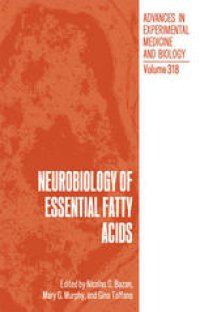
Ebook: Neurobiology of Essential Fatty Acids
- Tags: Pharmacology/Toxicology, Biochemistry general, Animal Anatomy / Morphology / Histology, Plant Sciences, Neurosciences
- Series: Advances in Experimental Medicine and Biology 318
- Year: 1992
- Publisher: Springer US
- Edition: 1
- Language: English
- pdf
It is increasingly evident that polyunsaturated fatty acids (PUFA), which in the past were often believed to be mere components of cellular membranes of neural tissue, are actually major determinants of the functional properties of neural cells and are intimately involved in brain disease processes. The two families of PUF A, which are derived from the essential polyenes, linoleic (18:26) and a-linolenic (18:33) acids, constitute a major proportion (-30%) of the total fatty acids esterified to brain phospholipids. Each family is distributed in membranes in a highly specific manner with respect to brain region, cell type, and position within each of the phosphoglycerides. Unlike their behavior in other organs, the PUF A components of brain turn over slowly and are relatively resistant to dietary modification. Their unique distribution and stability suggest that they play an important role in determining the functional properties of neural cells. However, until recently very little was known regarding the precise nature of their involvement.
Phospholipases A2: Brain Phospholipases and their Role in Signal Transduction; A.A. Farooqui, et al.Cell Signaling andEssential Fatty Acids: Reciprocal Regulation of Fatty Acid Release in the Brain by GABA and Glutamate; D.L. BirkleMetabolitesof Essential Fatty Acids and Other MembraneDerived Second Messengersin Cell Signaling: A Role for the Arachidonic Acid Cascade in Fast Synaptic Modulation A. Volterra, et al.Dietary Supply ofEssential Fatty Acids, Synaptogenesis, and PhotoreceptorBiogenesis: Network of Signal Transduction Pathways Involving Lipids; R. Bell et al.Essential Fatty Acids, ExcitableMembrane Phospholipids, and Pathophysiology: Conservation of Docosahexaenoic Acid in the Retina; R.E. Anderson, et al.Essential Fatty Acids and Excitable Membrane Phospholipids: Disposition Kinetics of Phospholipid Liposomes; P. Palatini 32 additional articles. Index.
Phospholipases A2: Brain Phospholipases and their Role in Signal Transduction; A.A. Farooqui, et al.Cell Signaling andEssential Fatty Acids: Reciprocal Regulation of Fatty Acid Release in the Brain by GABA and Glutamate; D.L. BirkleMetabolitesof Essential Fatty Acids and Other MembraneDerived Second Messengersin Cell Signaling: A Role for the Arachidonic Acid Cascade in Fast Synaptic Modulation A. Volterra, et al.Dietary Supply ofEssential Fatty Acids, Synaptogenesis, and PhotoreceptorBiogenesis: Network of Signal Transduction Pathways Involving Lipids; R. Bell et al.Essential Fatty Acids, ExcitableMembrane Phospholipids, and Pathophysiology: Conservation of Docosahexaenoic Acid in the Retina; R.E. Anderson, et al.Essential Fatty Acids and Excitable Membrane Phospholipids: Disposition Kinetics of Phospholipid Liposomes; P. Palatini 32 additional articles. Index.
Content:
Front Matter....Pages i-xi
The Induction of Cellular Group II Phospholipase A2 by Cytokines and its Prevention by Dexamethasone....Pages 1-10
Brain Phospholipases And Their Role In Signal Transduction....Pages 11-25
Ischemic Brain Damage: Focus On Lipids And Lipid Mediators....Pages 27-34
Reciprocal Regulation of Fatty Acid Release In The Brain By Gaba and Glutamate....Pages 35-39
NMDA Receptor-Mediated Arachidonic Acid Release In Neurons: Role In Signal Transduction and Pathological Aspects....Pages 41-56
Non-Eicosanoid Functions of Essential Fatty Acids: Regulation of Adenosine-Related Functions In Cultured Neuroblastoma Cells....Pages 57-71
Contributions To Arachidonic Acid Release In Mouse Cerebrum by The Phosphoinositide-Phospholipase C and Phospholipase A2 Pathways....Pages 73-89
Modulation of Arachidonic Acid Metabolism In Cultured Rat Astroglial Cells By Long-Chain N-3 Fatty Acids....Pages 91-102
Modulation of Glutamate Release From Hippocampal Mossy Fiber Nerve Endings By Arachidonic Acid And Eicosanoids....Pages 103-114
Metabotropic Glutamate Receptors and Neuronal Toxicity....Pages 115-120
A Role for The Arachidonic Acid Cascade In Fast Synaptic Modulation: Ion Channels and Transmitter Uptake Systems As Target Proteins....Pages 121-136
Essential Fatty Acid Deficiency In Cultured SK-N-SH Human Neuroblastoma Cells....Pages 137-145
Phospholipid Metabolism and Second Messenger System After Brain Ischemia....Pages 147-158
Impact of Dietary Fatty Acid Balance on Membrane Structure and Function of Neural Tissues....Pages 159-169
Structural and Functional Importance of Dietary Polyunsaturated Fatty Acids in the Nervous System....Pages 171-182
Long and Very Long Polyunsaturated Fatty Acids of Retina and Spermatozoa: The Whole Complement of Polyenoic Fatty Acid Series....Pages 183-195
Phospholipid Metabolism in Rat Intestinal Mucosa After Oral Administration of Lysophospholipids....Pages 197-210
Carbachol-Stimulated Release of Arachidonic Acid and Eicosanoids from Brain Cortex Synaptoneurosome Lipids of Adult and Aged Rats....Pages 211-229
Carbachol-Induced Stimulation of Inositol Phosphates, Arachidonic Acid and Prostaglandin F2? in Rabbit Retina....Pages 231-242
Induced and Spontaneous Seizures in Man Produce Increases in Regional Brain Lipid Detected By in Vivo Proton Magnetic Resonance Spectroscopy....Pages 243-249
Network of Signal Transduction Pathways Involving Lipids: Protein Kinase C-Dependent and -Independent Pathways....Pages 251-258
Conservation of Docosahexaenoic Acid in the Retina....Pages 259-265
Docosahexaenoic Acid Uptake and Metabolism in Photoreceptors: Retinal Conservation By an Efficient Retinal Pigment Epithelial Cell-Mediated Recycling Process....Pages 267-274
Essential Fatty Acids and Neurodevelopmental Disorder....Pages 275-284
Regulation of Arachidonic Acid Metabolism in the Perinatal Brain During Development and Under Ischemic Stress....Pages 285-294
Interactions of Phospholipids and Free Fatty Acids with Antidepressant Recognition Binding Sites in Rat Brain....Pages 295-306
Very Long-Chain Fatty Acids in Peroxisomal Disease....Pages 307-314
Long Chain Omega 3 Polyunsaturates In Formula-Fed Term Infants....Pages 315-323
Severe Changes in Polyunsaturated Fatty Acids in the Brain, Liver, Kidney, and Retina in Patients with Peroxisomal Disorders....Pages 325-330
Degradation of Phospholipids and Protein Kinase C Activation for the Control of Neuronal Functions....Pages 331-340
Disposition Kinetics of Phospholipid Liposomes....Pages 341-345
Behavioral and Morpho-Functional Correlates of Brain Aging: A Preclinical Study with Phosphatidylserine....Pages 347-359
Receptor Coupling to Phosphoinositide Signals....Pages 361-373
Diacylglycerol Composition and Metabolism in Peripheral Nerve....Pages 375-391
Back Matter....Pages 393-398
....Pages 399-411